Electric Bicycles
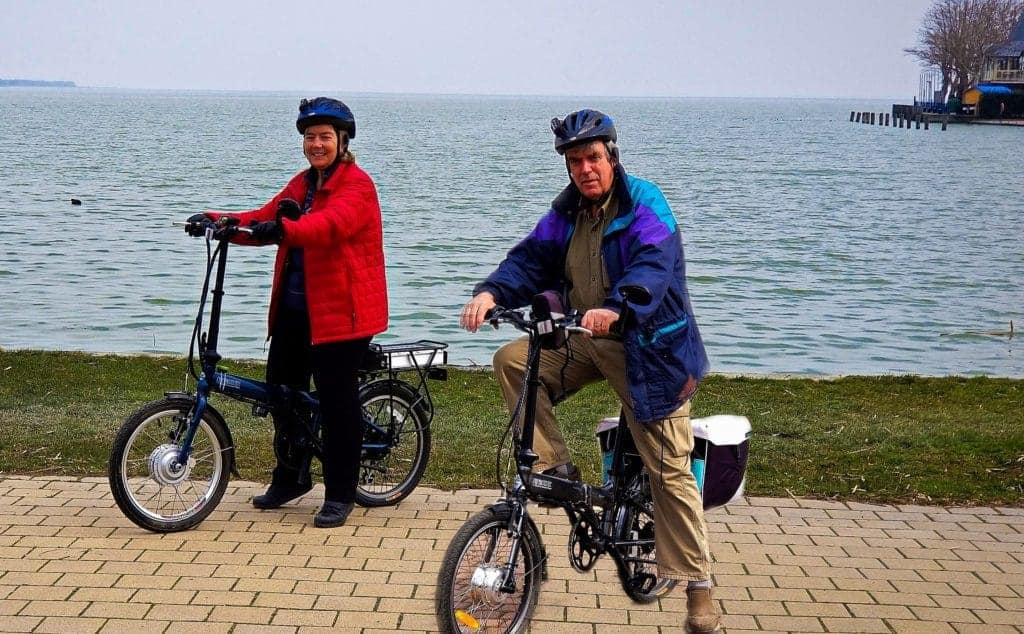
For those that aren’t interested in electric bikes you can skip this long article. I plan on covering the two main variations of electric bikes and our initial experiences. We have had a few friends that seemed interested in this topic, so this is a bit more detailed than most.
Last September Mike and I decided that electric bikes would be very good for us. In areas, such as Denmark and the Netherlands, where the ground was relatively flat we could easily bike for 20 miles (32 km) in a day and did so multiple times. The problem was that I cannot do hills or soft ground like dirt and grass. I don’t have the strength and I only see this getting worse over the years. We would often choose not to use our bikes either because we knew there where hills or, even worse, because we didn’t know what the terrain was and where chicken to try and find out on the bikes.
We investigated electric bikes in Europe and found out that the batteries all came with 220-volt chargers which won’t work in our camper. Although we could buy voltage transformers, it would take twice as long to charge the batteries and I wasn’t sure that it would be as good for the batteries. I looked into what was available in Toronto and was pleasantly surprised at the good selection. I figured that we could simply buy the bikes when we where home for Christmas and bring them back on the plane as luggage. We had decided that the bikes should be foldable. One problem in Europe is that most of their parking lots have been built underneath existing buildings in the cities. Our car, with our old bikes on the roof, was too high for these parking lots. We spent a lot of time driving around looking for street parking. With folding bikes we thought that we could store them in the truck and/or the back seat of the car.
Electric bikes come in two flavours: pedal assist and throttle. Basically, pedal assist kicks in when you are pedaling and helps make things easier. You can control the amount of assistance that you want. In throttle mode you don’t even need to pedal. It is like having a electric scooter to ride.
My intent wasn’t to ride a scooter but to still get the exercise of biking. This means that we want the pedal assist bike. When I saw that nearly all the bikes sold in Canada and the US come with both features on one bike I was thrilled. It was only later that we found out that in Europe bikes with throttle mode are illegal and need to be insured and licensed as motorcycles. Europe also has much tighter regulations for the speed that an e-bike can go and for the power in the motor than we do in North America. Our hope was that if we bought a North American electric bike, we could get away with it in Europe. We hope that we will be looked on as Canadians just traveling through a country and not really living there.
We came home and started looking for the bikes right away. We quickly ran into a problem with finding any for sale. There was a big difference between what was available in stores in September and what was available in December in Canada! Foldable bikes come with smaller wheels. Our old standard bikes have 26” wheels. The foldable electric bikes had wheels in the range of 12 – 20”. We decided that 20” was small enough. Any smaller and I felt like I was going to fall over when I tried riding it. Solo Rock is a company that imports all sorts of items from China, including electric bikes. The owner has a lot of input into the design of theses electric bikes in China and is very knowledgeable. He still had a few bikes with throttles and pedal assist and 20” wheels that folded up in stock.
I was concerned because these electric bikes have the motor on the front wheel. With e-bikes the motor can be on the front wheel, the rear wheel or in the centre. The centre is considered best with the front wheel motor being the least effective and the cheapest. We almost didn’t buy our bikes because of the front wheel motor. Solo Rock talked us into trying them and convinced us that they would do fine. Given that we the bike was already more powerful than was sold in Europe and that there was very little else available in December we decided to go for it. He had one model that had a quite a low centre bar, making it easy for me to step over when mounting and dismounting the bike.
It turns out that with electric bikes you need much wider, heavier tires than we had on our old bikes with street tires. Between the tires and the smaller wheels, pedaling the bike manually was much more difficult than my city bike had been. This meant that I would be using the pedal assist a lot more than our original plan of using it just for hills that we couldn’t bike up comfortably.
Mike and I decided to purchase two identical bikes. This way Mike would gain expertise on working on the bikes and we would only need one set of spare parts etc. We couldn’t give the bikes a good test as it was snowing outside. Due to an issue at Solo Rock our bikes ended up very similar but not identical. Just before our purchase we ran into a major problem. The batteries for the bikes are considered hazardous goods and cannot be shipped by plane, not even cargo planes. We were quoted more money to ship the two “hazardous” batteries by boat to Europe than it cost to ship our entire RV! After a week or two of trying to find a way to get the batteries to Europe Solo Rock agreed to ship the batteries direct from China to Hungary, which was great. They wouldn’t do that with the bikes as they needed more assembly and setup when they arrived.
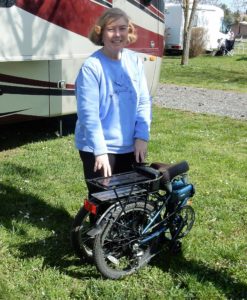 We discovered, after paying for additional luggage, that we couldn’t take the e-bikes with us on the plane due to their size. We had also realized that having these bikes in two large boxes, getting them off the plane in London, into a small British car and back onto a plane a few days later to fly to Hungary wasn’t going to be easy. We raced around trying to find an affordable boat to ship the bikes on. We found one that would actually deliver the bikes to our friends in Budapest and the boat was due to arrive about the same time we arrived. When we delivered our bikes, to the shipping agent we found out that the charges were twice what we expected. It was too late to change our plans at this stage. We had to pay import duties into Hungary that we wouldn’t have had to pay if the bikes had come on the plane with us. We were allowed to stuff our RV full without import duties and had to pay for two bikes that were basically just passing through Hungary.
We discovered, after paying for additional luggage, that we couldn’t take the e-bikes with us on the plane due to their size. We had also realized that having these bikes in two large boxes, getting them off the plane in London, into a small British car and back onto a plane a few days later to fly to Hungary wasn’t going to be easy. We raced around trying to find an affordable boat to ship the bikes on. We found one that would actually deliver the bikes to our friends in Budapest and the boat was due to arrive about the same time we arrived. When we delivered our bikes, to the shipping agent we found out that the charges were twice what we expected. It was too late to change our plans at this stage. We had to pay import duties into Hungary that we wouldn’t have had to pay if the bikes had come on the plane with us. We were allowed to stuff our RV full without import duties and had to pay for two bikes that were basically just passing through Hungary.
Mike had offered to spend a day or two at Solo Rock, helping out and learning about the mechanisms of an electric bike. This didn’t work out which was too bad. The bikes arrived in Hungary a few days after we did. It was very cold, and we took them out for about a 10-minute ride just to make sure they would work. I wasn’t happy. My bike was really touchy and tended to dart forward whenever it wanted to. I almost ran three people over. We put them away with plans to try them out better as soon as the weather improved a bit. If necessary, Mike would work with Solo Rock on the phone to try and see what, if any, the problems were. Instead of improving it got colder and we had some snow. We have now been in Europe for three weeks and we are staying in an area with a lot of bike paths. The temperatures are above freezing, and we have started testing the bikes wearing scarves and gloves.
Day One: We got on the bikes and I decided that mine behaved even worse that it had when we tested them in Budapest. I couldn’t control the speed properly, it would just jerk forward and then stop. I was under the impression that the motor would run while I was pedaling. It didn’t, it started and stopped. About ten minutes away from the RV, Mike suggested that we switch bikes. I don’t think that he really believed that mine was as bad as I said. He thought that I just didn’t know how to control it properly. He was wrong! Mike tried it for a minute or two and was horrified and said that we were going back to the RV to look at it. One problem was that Mike didn’t know where the sensor controlling the speed was located. As we were going back Mike noticed that one of my pedals was loose. When we got back Mike tightened the pedal and we discovered that the sensor must be in that area because the bike ran much better. We rode into town, about 6km away. It was mainly flat with one uphill section that the bikes handled fine. I decided that I could get used to the e-bike.
Day Two: The next day we started off on the bikes in the opposite direction. Again, I wasn’t very happy. It turned out that my pedal had come loose again, and we went back to the RV to get Mike’s tools. This time Mike removed the left pedal and found that someone had wound some tin foil around the shaft, presumably to act as a shim. However the tinfoil interfered with tightening the bolt that held the pedal on. He removed the tinfoil and reattached the pedal. We started out again and this time everything went fine. To be very fair to Solo Rock, I am sure that everything would have been sorted out quickly if we had been in Toronto.
Day Three: We headed back into town on our fully charged bikes. We got there OK and part way home my bike died. I couldn’t believe that my battery was dead after less than 10km. This would completely ruin our future biking plans if this was the norm. I knew that I was going to be using pedal assist most of the time, which had not been the original plan. I was hopeful that there was some problem other than the obvious one, as Mike’s battery was still running fine. Mike and I took turns manually pedaling my bike back to the campground. This means that Mike did 80% of the hard work while I rode alongside him on his electric bike most of the time. That night Mike took the battery case apart and got an electric spark while doing it. It turns out that both negative and positive connections to the charging port within the battery housing had never been connected properly or broken loose. Mike concluded that the battery had never been fully charged. After some messing around, because the existing wires were too short and needed to be extended by soldering in some additional wire, he put the battery back together and put it on the charger for the night. The batteries take 6 – 8 hours to fully charge.
Day Four: We rode the bikes into town and back again. They worked great. While there we bought two-day tickets to tour a local palace and some museums. When we got home we decided not to charge the batteries as we want to get an idea of how far we can go on a single charge. I know that this will change based on terrain, but I would really like a starting point. As it is, there is a town about 10 miles (16 km) from here that I would like to go to. The land is fairly flat but, since there are no taxis or anything at this time of year, I am too scared to try that distance without some knowledge on how far we can travel on a single charge.
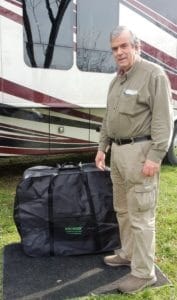 Day Five: So far, we have about 24 km on our current battery charge. The batteries still read as full. Mike and I are a little concerned that the battery indicators will jump from full to empty really quickly. I really want to run the batteries until they die. It is raining today and there is rain predicted for the next three days.
Day Five: So far, we have about 24 km on our current battery charge. The batteries still read as full. Mike and I are a little concerned that the battery indicators will jump from full to empty really quickly. I really want to run the batteries until they die. It is raining today and there is rain predicted for the next three days.
While we have been experimenting, Mike commented on the fact that pedaling harder didn’t make the pedal assist work harder as we had been led to expect. It seems that the variable control for the pedal assist was the only control for how much assistance you get from the motor. While writing this, I came across some information we hadn’t found in our previous search. It turns out that pedal assist bikes come in two flavours the torque sensor and the cadence sensor systems.
The torque sensor pedal assist systems measure the amount of power you are putting into the pedals and increase or decrease the electric assist based on your pedaling power. This is what I expected.
The cadence sensor system helps when the pedal cranks of the bike are turning. You could be pedaling very lightly or very hard and it will provide the same level of assist. Apparently, the torque sensor system is found on expensive e-bikes and we must have the less expensive system that I didn’t know existed. Still, you learn to work with what you have, and it seems to be working well for us.
Day 6 – 1pm: Rain looks like it has stopped for now and Mike is going on his own but taking both batteries with him. If one runs out he can switch batteries. Our phones can still find each other if I need to drive to rescue him. Mike is aiming for a town 12 km away. I expect the terrain will be mainly flat. I would have liked more hills for the test, but Mike wasn’t into that. I am staying in the RV working on my computer, updating this post and waiting to hear from him.
Day 6 – 5pm:
Rain held off and Mike is back for the second time. The battery died coming into the campground, what great timing. Today he rode 37 km, mostly flat, with the help of the batteries, still a big job and sore butt. If you add that to the previous 24 km on the battery it says that the battery lasted for 61 km or 38 miles on relatively flat ground. That is the good news. The bad news is that for 53 km the battery showed full, for 7 km it showed ½ full and then it was really empty. Mike did say that the charge indicator lights provided an earlier indication if one was alert. If you were accelerating or going up a hill and putting a load on the battery the light indicating “full” dimmed noticeably. He thinks this started happening about 20 km before the battery was fully depleted. Similarly, the “half” light dimmed during acceleration 7 or 8 km before the battery actually died. Although this was not exactly what we expected or hoped, it does mean that if we pay attention to the charge indicator lights during acceleration we can reduce the chances that we will be left stranded far from home with an empty battery. We do also need to be mindful that the distance would decrease dramatically if we were in a very hilly area.
Day 7: Poured rain
Day 8: We put the bikes into the back seat of the car and drove to some villages in the hills. We then unfolded the bikes and rode in an area that we would never have ridden in before and had a great time. We did find out that a magnetic, used to help close the bikes, must have broken off my bike during transit. I have faith that Mike will be able to fix it.
In summary: We think that the electric bikes are going to work out great, now that some of the kinks have been ironed out. Major lesson, we now know that we need to pay more attention to charge indicator lights (full/half full/empty) during acceleration and not when we are just cruising along. Life is good.

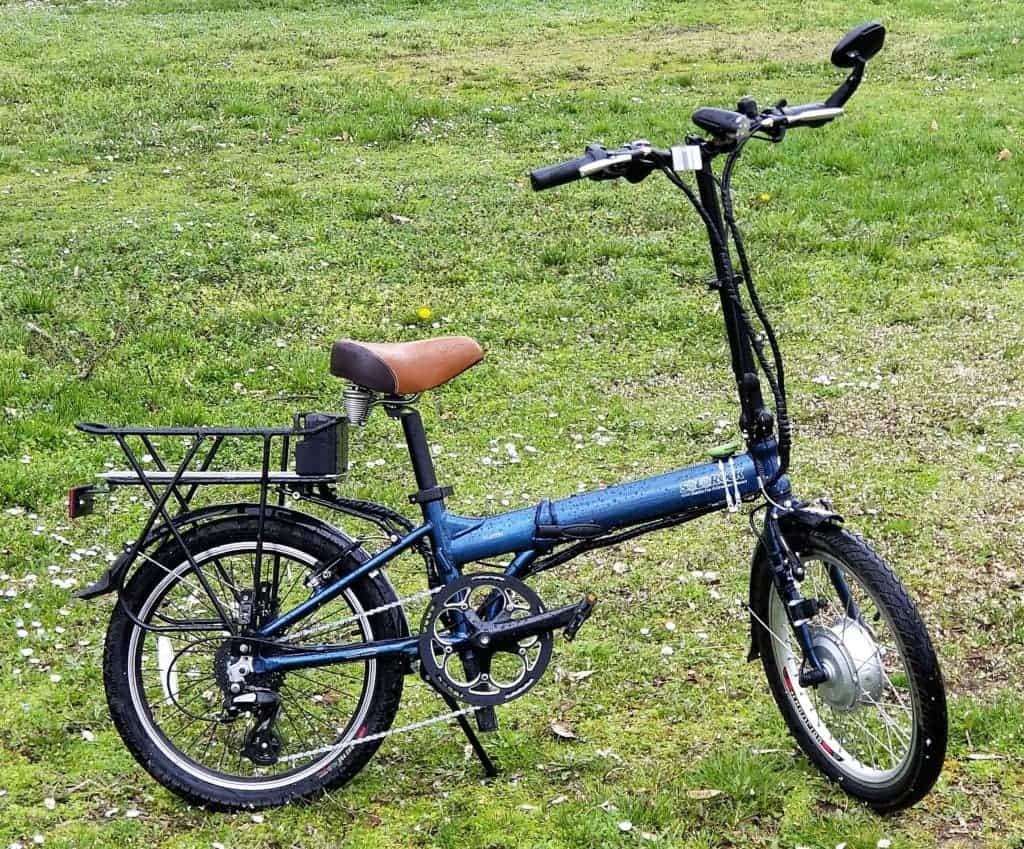
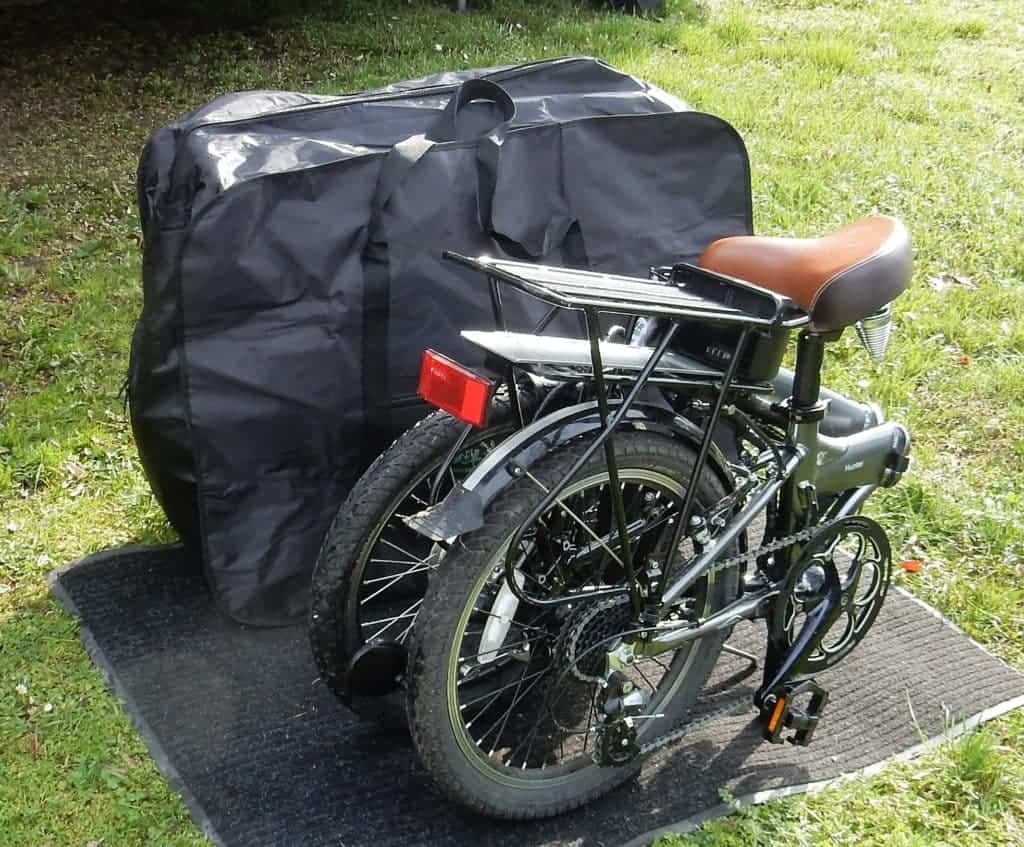
Leave a Reply